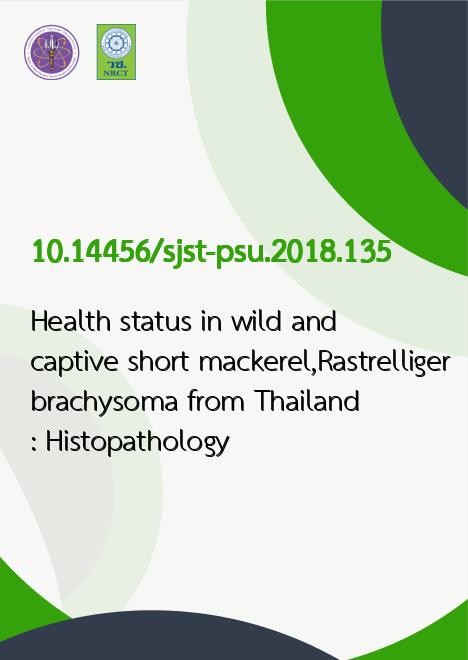
|
Health status in wild and captive short mackerel,Rastrelliger brachysoma from Thailand: Histopathology |
|---|---|
| รหัสดีโอไอ | |
| Creator | 1. Sinlapachai Senarat 2. Jes Kettratad 3. Sasipong Tipdomrongpong 4. F. Gerald Plumley 5. Wannee Jiraungkoorskul 6. Pisit Poolprasert |
| Title | Health status in wild and captive short mackerel,Rastrelliger brachysoma from Thailand: Histopathology |
| Publisher | Research and Development Office, Prince of Songkla University |
| Publication Year | 2561 |
| Journal Title | Songklanakarin Journal of Science and Technology |
| Journal Vol. | 40 |
| Journal No. | 5 |
| Page no. | 1090-1097 |
| Keyword | fish health, Gulf of Thailand, histopathology, short mackerel |
| URL Website | http://rdo.psu.ac.th/sjstweb/index.php |
| ISSN | 0125-3395 |
| Abstract | Information regarding the health status of wild and captive Rastrelliger brachysoma (Bleeker, 1851) is scanty. This is aneconomically/ ecologically important fish species in Thailand which has experienced recent dramatic declines in populationnumbers. Therefore, the aim of this research was to assess the health status of this fish using histopathology as biomarker. Theresults revealed previously the gill lesions including lamellae disorganization, fusion and edema with lifting of lamellar epitheliumin the secondary lamellae. The skin histopathology included epidermal hyperplasia and the proliferation of the Malpighian cells.Pyknotic nuclei and vacuolar degeneration of exocrine acinar cells were detected in the pancreas tissue. Degeneration of the renalparenchyma and tubules as well as the melanomacrophage center (MMC) was observed in kidney tissue. In captive fish, the mostcommon histopathology of gill tissue, primary lamellae disorganization and degeneration of secondary gills, was observed in allsamples. In some areas of the kidney tissues, renal degeneration and damage to the glomeruli throughout the majority of themacrophage aggregates (MMC) were also found. Important histopathological observations of liver tissue were hepaticdegeneration, focal coagulation necrosis and increased frequency of MMC. Interestingly, a gastric tumor was observed in only onemale specimen. Additionally, it must be emphasized that histopathological alterations are an effective biomarker used to evaluatepotential effects of the environmental pollution on fish health and marine biota. |
